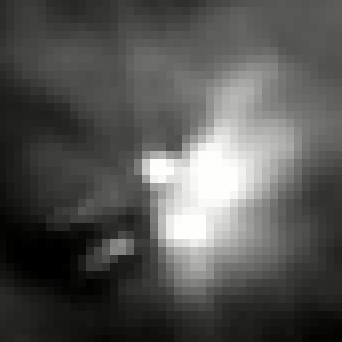
A reprocessed version of this observation is now available
Many newly born stars have been observed by ISOCAM, the camera of ISO, in the nearby interstellar cloud known to astronomers as Rho Ophiuchi. Stars are born (birth triggered by gravitational instabilities) inside dusty clouds such as Rho Ophiuchi. As they grow up they leave their birth grounds. Such stars make the Rho Ophiuchi nursery glow with a faint infrared light as can be seen in the photograph obtained by ISOCAM.
The Rho Ophiuchi cloud: distance to Earth about 500 light years.

In optical images: it appears as a region devoid of stars, with a characteristic crescent shape and two long horns. This is because it is a dense cloud of gas and dust, completely opaque to optical light, so in the optical we only see the few stars between us and the cloud. (The IRAS infrared image, at 100 microns, appears like the negative of the optical image: the dust grains of the cloud emit this far infrared radiation, characteristic of their low temperature. But IRAS had a low spatial accuracy, and the details of the cloud remained unknown.)

The all-sky IRAS Survey Atlas image, at 12 microns.
This ISOCAM images the first allowing us to see details of the interior of this cloud, thanks to the more penetrating power of the infrared light in such clouds. It is a colour composite, made in two infrared colours: blue is radiation around 7 microns, red around 15. Blue = hotter regions, red = cooler regions. The image covers half a square degree, over all the dense part of the cloud. The stars seen on this picture are young stars, recently formed in this cloud. They are stars of relatively low mass, comparable to our sun.
The bright region at the upper right of the middle of the picture is a very young, more massive star (several tens of solar masses), emitting ultraviolet and optical light which is absorbed by the dust and re-emitted in the infrared. We believe that the small glowing cloud around the star is the placental cloud out of which this star was formed. The large wisp at the right at the interface between the dense cold and very narrow filament (width 1.5 light years only).
This detailed picture reveals regions of the cloud that are so dense that even these infrared rays do not penetrate or escape. These are the darkest regions here. The most conspicuous ones are around the central part of the picture.
In another of them, between the cloud illuminated by the massive star and the cold filament, radio observations (P. Andre et al) have allowed us to find the youngest star known, of age 10000 years. This object is too cold to be seen even by ISOCAM. The right corner is a less dense region, where again the gas of the cloud is illuminated by a young massive star.
IRAS observations had revealed unexpected emission of diffuse clouds around 12 microns. Until now, astronomers could only speculate about the origin of this emission, ubiquitous in our and other galaxies, and inaccessible to all available instruments. ISOCAM, with its unprecedented sensitivity, is able to study this radiation and even decompose it in its various spatial and spectral components. The halo of the Rho Ophiuchi cloud is a source of this peculiar emission. ISOCAM has taken a spectrum of this halo light (not shown here), at the upper right corner of this image. In it, the unmistakable signatures of hydrocarbons appear, demonstrating that this mysterious glow is all due to interaction of hydrogen and carbon atoms attached to large molecules or grains.
14 June 1996